University Business Law Assignment: Company Structure and Liability
VerifiedAdded on 2022/09/15
|9
|2161
|9
Homework Assignment
AI Summary
This assignment solution addresses a business law case study involving Bill and Mary, who seek advice on establishing a property management business. The solution explores various business structures, including sole proprietorship and company structures, outlining the steps for registration, and discussing the advantages and disadvantages of each. It covers the inclusion of co-owners, the features of a company, and the process of registering a company with ASIC. The solution also addresses the need for limited liability to protect personal assets, offering strategies such as dual company arrangements and professional indemnity insurance. Furthermore, it details the legal and reporting obligations of a company, including GST registration and tax requirements, emphasizing the differences between company structures and sole proprietorships. The solution also considers the potential for Steve to join the business and contribute capital, further exploring the complexities of business structure and management.

Running head: BUSINESS LAW
BUSINESS LAW
Name of the student
Name of the university
Author note
BUSINESS LAW
Name of the student
Name of the university
Author note
Paraphrase This Document
Need a fresh take? Get an instant paraphrase of this document with our AI Paraphraser
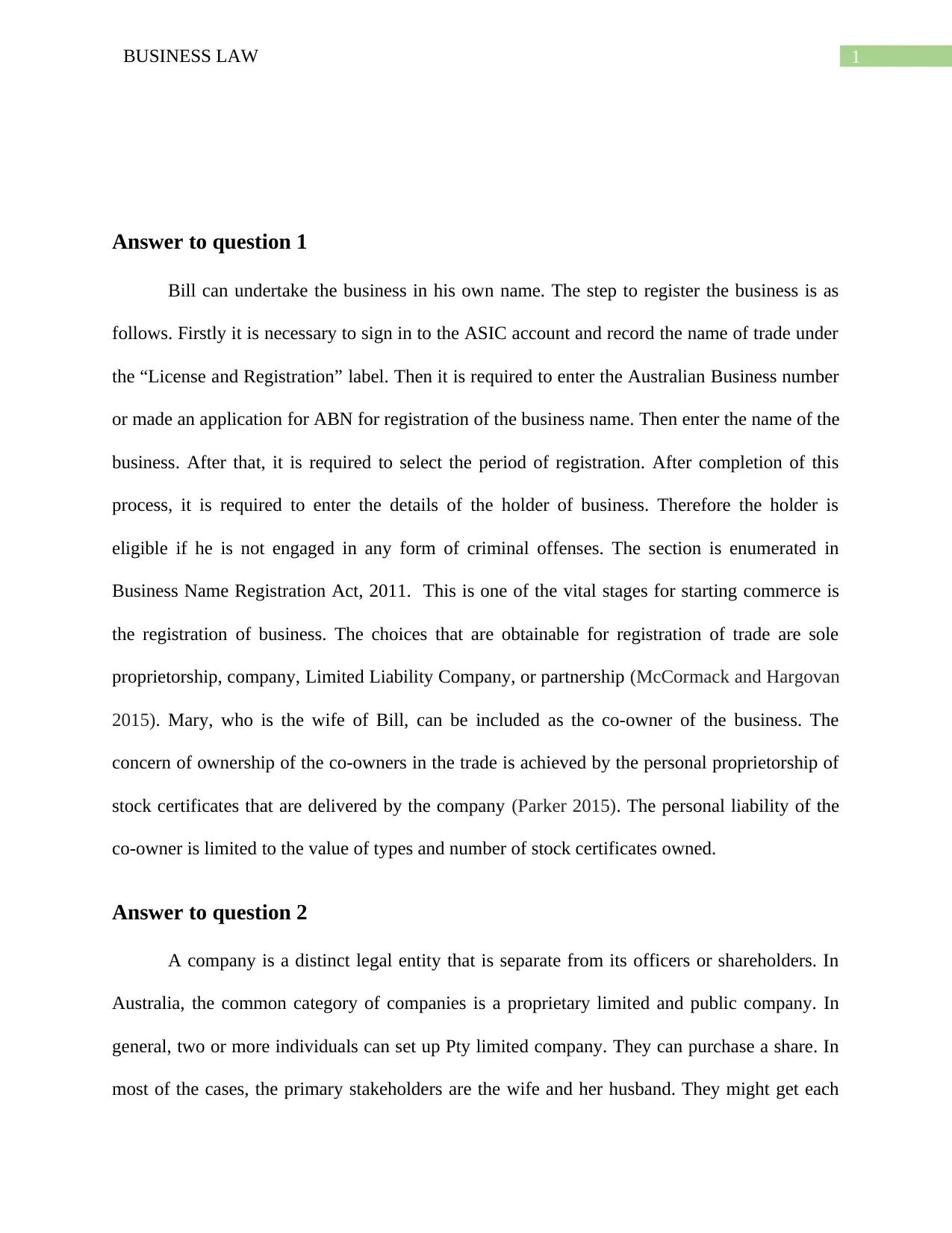
1BUSINESS LAW
Answer to question 1
Bill can undertake the business in his own name. The step to register the business is as
follows. Firstly it is necessary to sign in to the ASIC account and record the name of trade under
the “License and Registration” label. Then it is required to enter the Australian Business number
or made an application for ABN for registration of the business name. Then enter the name of the
business. After that, it is required to select the period of registration. After completion of this
process, it is required to enter the details of the holder of business. Therefore the holder is
eligible if he is not engaged in any form of criminal offenses. The section is enumerated in
Business Name Registration Act, 2011. This is one of the vital stages for starting commerce is
the registration of business. The choices that are obtainable for registration of trade are sole
proprietorship, company, Limited Liability Company, or partnership (McCormack and Hargovan
2015). Mary, who is the wife of Bill, can be included as the co-owner of the business. The
concern of ownership of the co-owners in the trade is achieved by the personal proprietorship of
stock certificates that are delivered by the company (Parker 2015). The personal liability of the
co-owner is limited to the value of types and number of stock certificates owned.
Answer to question 2
A company is a distinct legal entity that is separate from its officers or shareholders. In
Australia, the common category of companies is a proprietary limited and public company. In
general, two or more individuals can set up Pty limited company. They can purchase a share. In
most of the cases, the primary stakeholders are the wife and her husband. They might get each
Answer to question 1
Bill can undertake the business in his own name. The step to register the business is as
follows. Firstly it is necessary to sign in to the ASIC account and record the name of trade under
the “License and Registration” label. Then it is required to enter the Australian Business number
or made an application for ABN for registration of the business name. Then enter the name of the
business. After that, it is required to select the period of registration. After completion of this
process, it is required to enter the details of the holder of business. Therefore the holder is
eligible if he is not engaged in any form of criminal offenses. The section is enumerated in
Business Name Registration Act, 2011. This is one of the vital stages for starting commerce is
the registration of business. The choices that are obtainable for registration of trade are sole
proprietorship, company, Limited Liability Company, or partnership (McCormack and Hargovan
2015). Mary, who is the wife of Bill, can be included as the co-owner of the business. The
concern of ownership of the co-owners in the trade is achieved by the personal proprietorship of
stock certificates that are delivered by the company (Parker 2015). The personal liability of the
co-owner is limited to the value of types and number of stock certificates owned.
Answer to question 2
A company is a distinct legal entity that is separate from its officers or shareholders. In
Australia, the common category of companies is a proprietary limited and public company. In
general, two or more individuals can set up Pty limited company. They can purchase a share. In
most of the cases, the primary stakeholders are the wife and her husband. They might get each
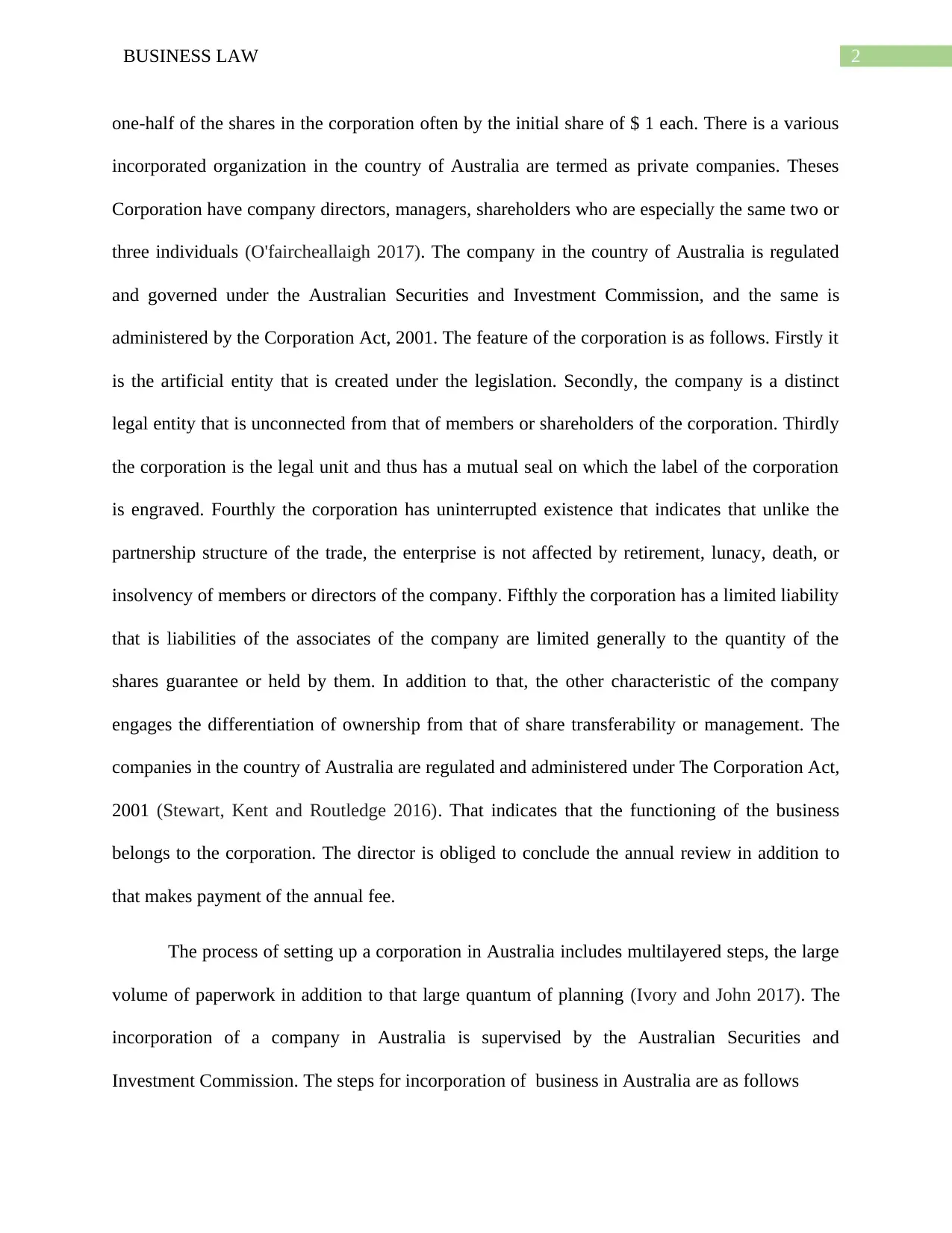
2BUSINESS LAW
one-half of the shares in the corporation often by the initial share of $ 1 each. There is a various
incorporated organization in the country of Australia are termed as private companies. Theses
Corporation have company directors, managers, shareholders who are especially the same two or
three individuals (O'faircheallaigh 2017). The company in the country of Australia is regulated
and governed under the Australian Securities and Investment Commission, and the same is
administered by the Corporation Act, 2001. The feature of the corporation is as follows. Firstly it
is the artificial entity that is created under the legislation. Secondly, the company is a distinct
legal entity that is unconnected from that of members or shareholders of the corporation. Thirdly
the corporation is the legal unit and thus has a mutual seal on which the label of the corporation
is engraved. Fourthly the corporation has uninterrupted existence that indicates that unlike the
partnership structure of the trade, the enterprise is not affected by retirement, lunacy, death, or
insolvency of members or directors of the company. Fifthly the corporation has a limited liability
that is liabilities of the associates of the company are limited generally to the quantity of the
shares guarantee or held by them. In addition to that, the other characteristic of the company
engages the differentiation of ownership from that of share transferability or management. The
companies in the country of Australia are regulated and administered under The Corporation Act,
2001 (Stewart, Kent and Routledge 2016). That indicates that the functioning of the business
belongs to the corporation. The director is obliged to conclude the annual review in addition to
that makes payment of the annual fee.
The process of setting up a corporation in Australia includes multilayered steps, the large
volume of paperwork in addition to that large quantum of planning (Ivory and John 2017). The
incorporation of a company in Australia is supervised by the Australian Securities and
Investment Commission. The steps for incorporation of business in Australia are as follows
one-half of the shares in the corporation often by the initial share of $ 1 each. There is a various
incorporated organization in the country of Australia are termed as private companies. Theses
Corporation have company directors, managers, shareholders who are especially the same two or
three individuals (O'faircheallaigh 2017). The company in the country of Australia is regulated
and governed under the Australian Securities and Investment Commission, and the same is
administered by the Corporation Act, 2001. The feature of the corporation is as follows. Firstly it
is the artificial entity that is created under the legislation. Secondly, the company is a distinct
legal entity that is unconnected from that of members or shareholders of the corporation. Thirdly
the corporation is the legal unit and thus has a mutual seal on which the label of the corporation
is engraved. Fourthly the corporation has uninterrupted existence that indicates that unlike the
partnership structure of the trade, the enterprise is not affected by retirement, lunacy, death, or
insolvency of members or directors of the company. Fifthly the corporation has a limited liability
that is liabilities of the associates of the company are limited generally to the quantity of the
shares guarantee or held by them. In addition to that, the other characteristic of the company
engages the differentiation of ownership from that of share transferability or management. The
companies in the country of Australia are regulated and administered under The Corporation Act,
2001 (Stewart, Kent and Routledge 2016). That indicates that the functioning of the business
belongs to the corporation. The director is obliged to conclude the annual review in addition to
that makes payment of the annual fee.
The process of setting up a corporation in Australia includes multilayered steps, the large
volume of paperwork in addition to that large quantum of planning (Ivory and John 2017). The
incorporation of a company in Australia is supervised by the Australian Securities and
Investment Commission. The steps for incorporation of business in Australia are as follows
⊘ This is a preview!⊘
Do you want full access?
Subscribe today to unlock all pages.

Trusted by 1+ million students worldwide
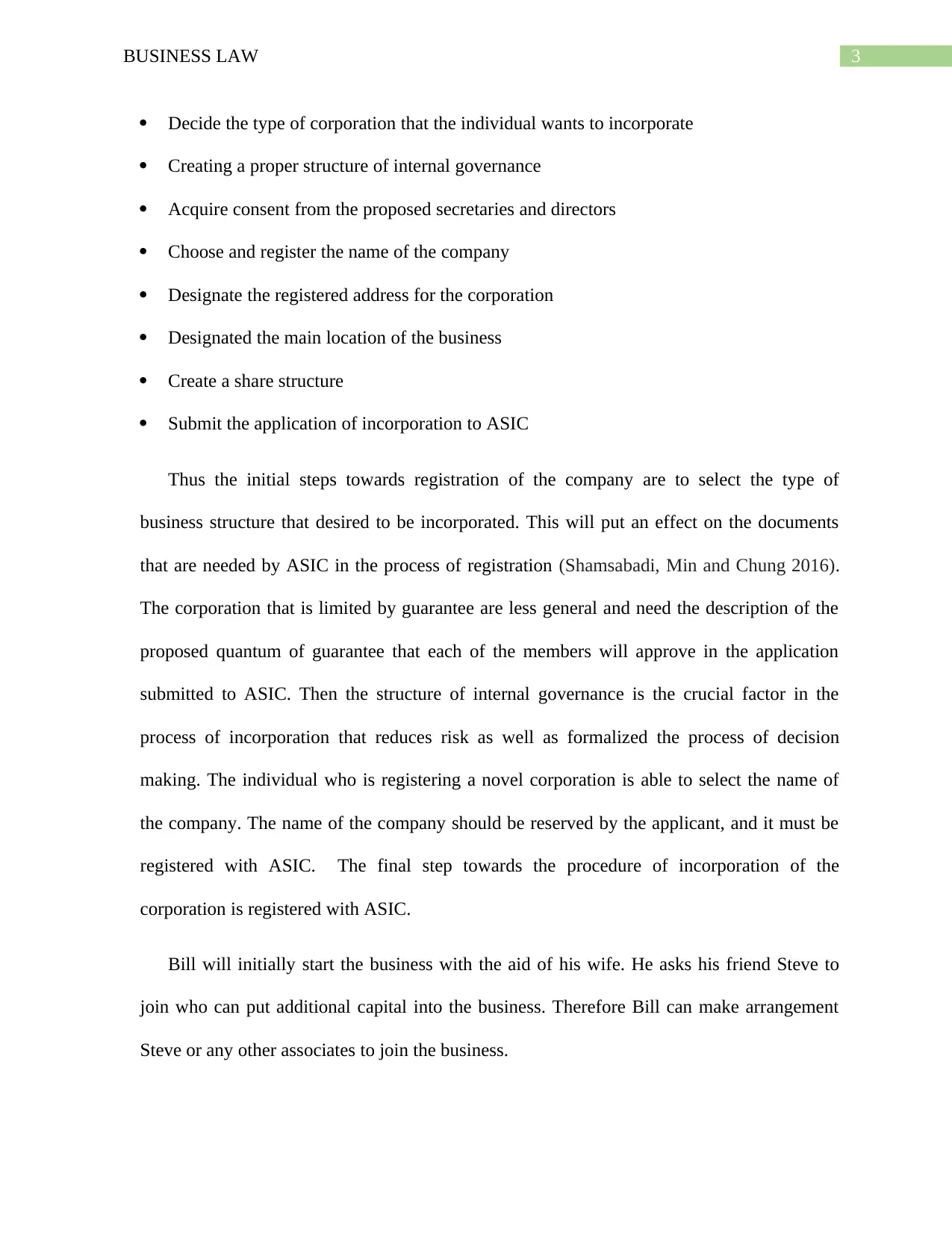
3BUSINESS LAW
Decide the type of corporation that the individual wants to incorporate
Creating a proper structure of internal governance
Acquire consent from the proposed secretaries and directors
Choose and register the name of the company
Designate the registered address for the corporation
Designated the main location of the business
Create a share structure
Submit the application of incorporation to ASIC
Thus the initial steps towards registration of the company are to select the type of
business structure that desired to be incorporated. This will put an effect on the documents
that are needed by ASIC in the process of registration (Shamsabadi, Min and Chung 2016).
The corporation that is limited by guarantee are less general and need the description of the
proposed quantum of guarantee that each of the members will approve in the application
submitted to ASIC. Then the structure of internal governance is the crucial factor in the
process of incorporation that reduces risk as well as formalized the process of decision
making. The individual who is registering a novel corporation is able to select the name of
the company. The name of the company should be reserved by the applicant, and it must be
registered with ASIC. The final step towards the procedure of incorporation of the
corporation is registered with ASIC.
Bill will initially start the business with the aid of his wife. He asks his friend Steve to
join who can put additional capital into the business. Therefore Bill can make arrangement
Steve or any other associates to join the business.
Decide the type of corporation that the individual wants to incorporate
Creating a proper structure of internal governance
Acquire consent from the proposed secretaries and directors
Choose and register the name of the company
Designate the registered address for the corporation
Designated the main location of the business
Create a share structure
Submit the application of incorporation to ASIC
Thus the initial steps towards registration of the company are to select the type of
business structure that desired to be incorporated. This will put an effect on the documents
that are needed by ASIC in the process of registration (Shamsabadi, Min and Chung 2016).
The corporation that is limited by guarantee are less general and need the description of the
proposed quantum of guarantee that each of the members will approve in the application
submitted to ASIC. Then the structure of internal governance is the crucial factor in the
process of incorporation that reduces risk as well as formalized the process of decision
making. The individual who is registering a novel corporation is able to select the name of
the company. The name of the company should be reserved by the applicant, and it must be
registered with ASIC. The final step towards the procedure of incorporation of the
corporation is registered with ASIC.
Bill will initially start the business with the aid of his wife. He asks his friend Steve to
join who can put additional capital into the business. Therefore Bill can make arrangement
Steve or any other associates to join the business.
Paraphrase This Document
Need a fresh take? Get an instant paraphrase of this document with our AI Paraphraser
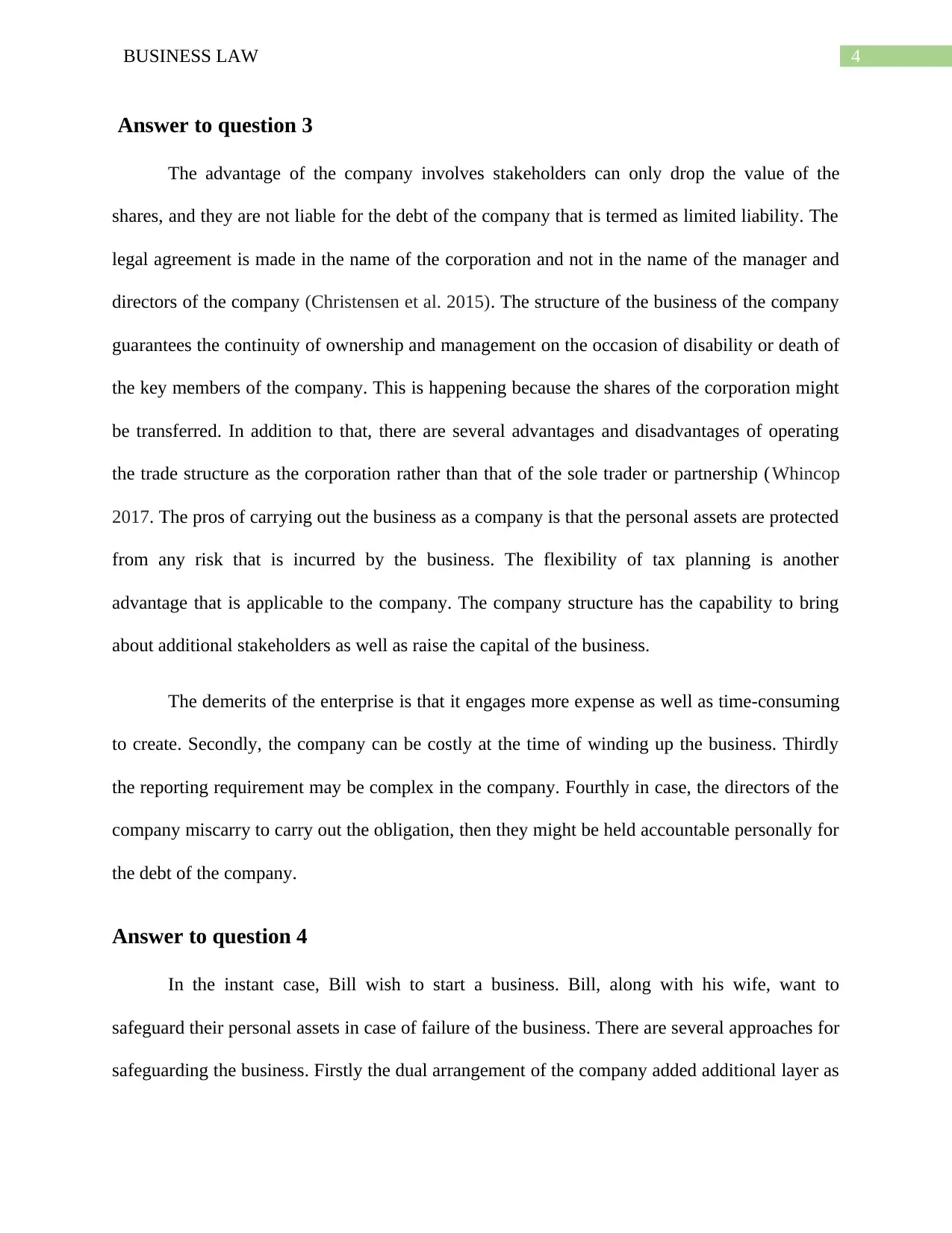
4BUSINESS LAW
Answer to question 3
The advantage of the company involves stakeholders can only drop the value of the
shares, and they are not liable for the debt of the company that is termed as limited liability. The
legal agreement is made in the name of the corporation and not in the name of the manager and
directors of the company (Christensen et al. 2015). The structure of the business of the company
guarantees the continuity of ownership and management on the occasion of disability or death of
the key members of the company. This is happening because the shares of the corporation might
be transferred. In addition to that, there are several advantages and disadvantages of operating
the trade structure as the corporation rather than that of the sole trader or partnership (Whincop
2017. The pros of carrying out the business as a company is that the personal assets are protected
from any risk that is incurred by the business. The flexibility of tax planning is another
advantage that is applicable to the company. The company structure has the capability to bring
about additional stakeholders as well as raise the capital of the business.
The demerits of the enterprise is that it engages more expense as well as time-consuming
to create. Secondly, the company can be costly at the time of winding up the business. Thirdly
the reporting requirement may be complex in the company. Fourthly in case, the directors of the
company miscarry to carry out the obligation, then they might be held accountable personally for
the debt of the company.
Answer to question 4
In the instant case, Bill wish to start a business. Bill, along with his wife, want to
safeguard their personal assets in case of failure of the business. There are several approaches for
safeguarding the business. Firstly the dual arrangement of the company added additional layer as
Answer to question 3
The advantage of the company involves stakeholders can only drop the value of the
shares, and they are not liable for the debt of the company that is termed as limited liability. The
legal agreement is made in the name of the corporation and not in the name of the manager and
directors of the company (Christensen et al. 2015). The structure of the business of the company
guarantees the continuity of ownership and management on the occasion of disability or death of
the key members of the company. This is happening because the shares of the corporation might
be transferred. In addition to that, there are several advantages and disadvantages of operating
the trade structure as the corporation rather than that of the sole trader or partnership (Whincop
2017. The pros of carrying out the business as a company is that the personal assets are protected
from any risk that is incurred by the business. The flexibility of tax planning is another
advantage that is applicable to the company. The company structure has the capability to bring
about additional stakeholders as well as raise the capital of the business.
The demerits of the enterprise is that it engages more expense as well as time-consuming
to create. Secondly, the company can be costly at the time of winding up the business. Thirdly
the reporting requirement may be complex in the company. Fourthly in case, the directors of the
company miscarry to carry out the obligation, then they might be held accountable personally for
the debt of the company.
Answer to question 4
In the instant case, Bill wish to start a business. Bill, along with his wife, want to
safeguard their personal assets in case of failure of the business. There are several approaches for
safeguarding the business. Firstly the dual arrangement of the company added additional layer as
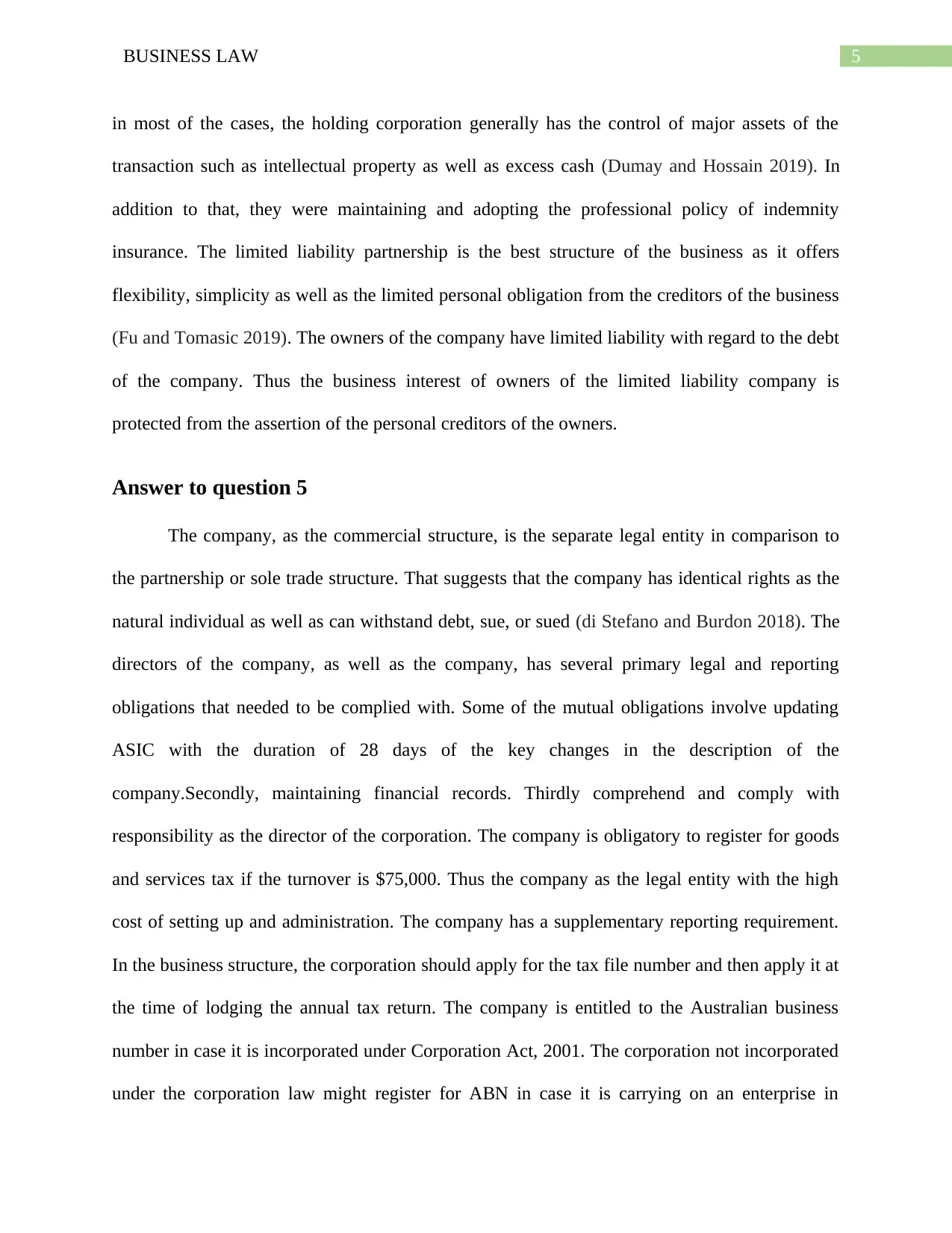
5BUSINESS LAW
in most of the cases, the holding corporation generally has the control of major assets of the
transaction such as intellectual property as well as excess cash (Dumay and Hossain 2019). In
addition to that, they were maintaining and adopting the professional policy of indemnity
insurance. The limited liability partnership is the best structure of the business as it offers
flexibility, simplicity as well as the limited personal obligation from the creditors of the business
(Fu and Tomasic 2019). The owners of the company have limited liability with regard to the debt
of the company. Thus the business interest of owners of the limited liability company is
protected from the assertion of the personal creditors of the owners.
Answer to question 5
The company, as the commercial structure, is the separate legal entity in comparison to
the partnership or sole trade structure. That suggests that the company has identical rights as the
natural individual as well as can withstand debt, sue, or sued (di Stefano and Burdon 2018). The
directors of the company, as well as the company, has several primary legal and reporting
obligations that needed to be complied with. Some of the mutual obligations involve updating
ASIC with the duration of 28 days of the key changes in the description of the
company.Secondly, maintaining financial records. Thirdly comprehend and comply with
responsibility as the director of the corporation. The company is obligatory to register for goods
and services tax if the turnover is $75,000. Thus the company as the legal entity with the high
cost of setting up and administration. The company has a supplementary reporting requirement.
In the business structure, the corporation should apply for the tax file number and then apply it at
the time of lodging the annual tax return. The company is entitled to the Australian business
number in case it is incorporated under Corporation Act, 2001. The corporation not incorporated
under the corporation law might register for ABN in case it is carrying on an enterprise in
in most of the cases, the holding corporation generally has the control of major assets of the
transaction such as intellectual property as well as excess cash (Dumay and Hossain 2019). In
addition to that, they were maintaining and adopting the professional policy of indemnity
insurance. The limited liability partnership is the best structure of the business as it offers
flexibility, simplicity as well as the limited personal obligation from the creditors of the business
(Fu and Tomasic 2019). The owners of the company have limited liability with regard to the debt
of the company. Thus the business interest of owners of the limited liability company is
protected from the assertion of the personal creditors of the owners.
Answer to question 5
The company, as the commercial structure, is the separate legal entity in comparison to
the partnership or sole trade structure. That suggests that the company has identical rights as the
natural individual as well as can withstand debt, sue, or sued (di Stefano and Burdon 2018). The
directors of the company, as well as the company, has several primary legal and reporting
obligations that needed to be complied with. Some of the mutual obligations involve updating
ASIC with the duration of 28 days of the key changes in the description of the
company.Secondly, maintaining financial records. Thirdly comprehend and comply with
responsibility as the director of the corporation. The company is obligatory to register for goods
and services tax if the turnover is $75,000. Thus the company as the legal entity with the high
cost of setting up and administration. The company has a supplementary reporting requirement.
In the business structure, the corporation should apply for the tax file number and then apply it at
the time of lodging the annual tax return. The company is entitled to the Australian business
number in case it is incorporated under Corporation Act, 2001. The corporation not incorporated
under the corporation law might register for ABN in case it is carrying on an enterprise in
⊘ This is a preview!⊘
Do you want full access?
Subscribe today to unlock all pages.

Trusted by 1+ million students worldwide
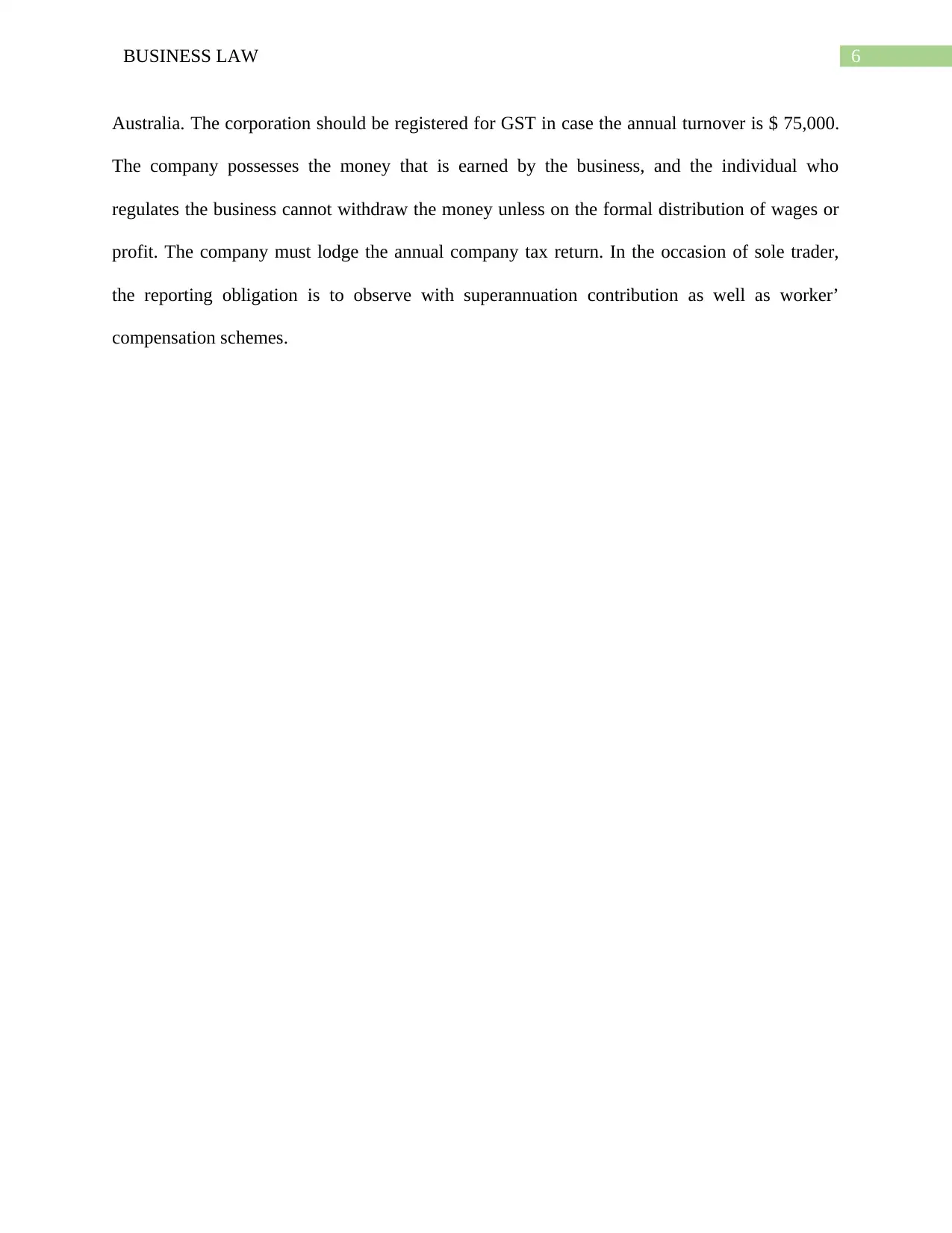
6BUSINESS LAW
Australia. The corporation should be registered for GST in case the annual turnover is $ 75,000.
The company possesses the money that is earned by the business, and the individual who
regulates the business cannot withdraw the money unless on the formal distribution of wages or
profit. The company must lodge the annual company tax return. In the occasion of sole trader,
the reporting obligation is to observe with superannuation contribution as well as worker’
compensation schemes.
Australia. The corporation should be registered for GST in case the annual turnover is $ 75,000.
The company possesses the money that is earned by the business, and the individual who
regulates the business cannot withdraw the money unless on the formal distribution of wages or
profit. The company must lodge the annual company tax return. In the occasion of sole trader,
the reporting obligation is to observe with superannuation contribution as well as worker’
compensation schemes.
Paraphrase This Document
Need a fresh take? Get an instant paraphrase of this document with our AI Paraphraser
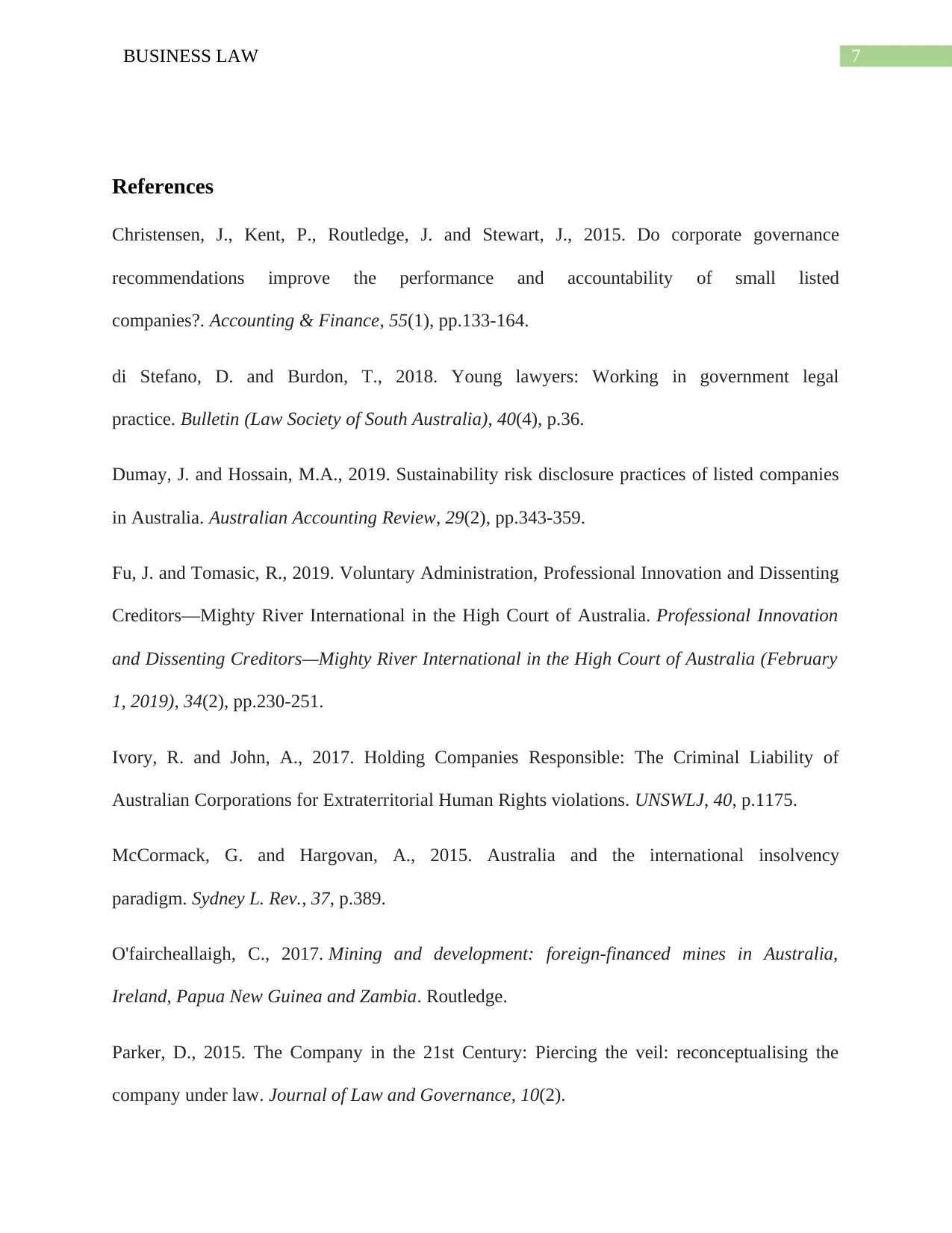
7BUSINESS LAW
References
Christensen, J., Kent, P., Routledge, J. and Stewart, J., 2015. Do corporate governance
recommendations improve the performance and accountability of small listed
companies?. Accounting & Finance, 55(1), pp.133-164.
di Stefano, D. and Burdon, T., 2018. Young lawyers: Working in government legal
practice. Bulletin (Law Society of South Australia), 40(4), p.36.
Dumay, J. and Hossain, M.A., 2019. Sustainability risk disclosure practices of listed companies
in Australia. Australian Accounting Review, 29(2), pp.343-359.
Fu, J. and Tomasic, R., 2019. Voluntary Administration, Professional Innovation and Dissenting
Creditors—Mighty River International in the High Court of Australia. Professional Innovation
and Dissenting Creditors—Mighty River International in the High Court of Australia (February
1, 2019), 34(2), pp.230-251.
Ivory, R. and John, A., 2017. Holding Companies Responsible: The Criminal Liability of
Australian Corporations for Extraterritorial Human Rights violations. UNSWLJ, 40, p.1175.
McCormack, G. and Hargovan, A., 2015. Australia and the international insolvency
paradigm. Sydney L. Rev., 37, p.389.
O'faircheallaigh, C., 2017. Mining and development: foreign-financed mines in Australia,
Ireland, Papua New Guinea and Zambia. Routledge.
Parker, D., 2015. The Company in the 21st Century: Piercing the veil: reconceptualising the
company under law. Journal of Law and Governance, 10(2).
References
Christensen, J., Kent, P., Routledge, J. and Stewart, J., 2015. Do corporate governance
recommendations improve the performance and accountability of small listed
companies?. Accounting & Finance, 55(1), pp.133-164.
di Stefano, D. and Burdon, T., 2018. Young lawyers: Working in government legal
practice. Bulletin (Law Society of South Australia), 40(4), p.36.
Dumay, J. and Hossain, M.A., 2019. Sustainability risk disclosure practices of listed companies
in Australia. Australian Accounting Review, 29(2), pp.343-359.
Fu, J. and Tomasic, R., 2019. Voluntary Administration, Professional Innovation and Dissenting
Creditors—Mighty River International in the High Court of Australia. Professional Innovation
and Dissenting Creditors—Mighty River International in the High Court of Australia (February
1, 2019), 34(2), pp.230-251.
Ivory, R. and John, A., 2017. Holding Companies Responsible: The Criminal Liability of
Australian Corporations for Extraterritorial Human Rights violations. UNSWLJ, 40, p.1175.
McCormack, G. and Hargovan, A., 2015. Australia and the international insolvency
paradigm. Sydney L. Rev., 37, p.389.
O'faircheallaigh, C., 2017. Mining and development: foreign-financed mines in Australia,
Ireland, Papua New Guinea and Zambia. Routledge.
Parker, D., 2015. The Company in the 21st Century: Piercing the veil: reconceptualising the
company under law. Journal of Law and Governance, 10(2).

8BUSINESS LAW
Shamsabadi, H.A., Min, B.S. and Chung, R., 2016. Corporate governance and dividend strategy:
lessons from Australia. International Journal of Managerial Finance.
Stewart, J., Kent, P. and Routledge, J., 2016. The association between audit partner rotation and
audit fees: Empirical evidence from the Australian market. Auditing: A Journal of Practice &
Theory, 35(1), pp.181-197.
Whincop, M.J., 2017. Corporate governance in government corporations. Routledge.
Shamsabadi, H.A., Min, B.S. and Chung, R., 2016. Corporate governance and dividend strategy:
lessons from Australia. International Journal of Managerial Finance.
Stewart, J., Kent, P. and Routledge, J., 2016. The association between audit partner rotation and
audit fees: Empirical evidence from the Australian market. Auditing: A Journal of Practice &
Theory, 35(1), pp.181-197.
Whincop, M.J., 2017. Corporate governance in government corporations. Routledge.
⊘ This is a preview!⊘
Do you want full access?
Subscribe today to unlock all pages.

Trusted by 1+ million students worldwide
1 out of 9
Related Documents
Your All-in-One AI-Powered Toolkit for Academic Success.
+13062052269
info@desklib.com
Available 24*7 on WhatsApp / Email
![[object Object]](/_next/static/media/star-bottom.7253800d.svg)
Unlock your academic potential
Copyright © 2020–2025 A2Z Services. All Rights Reserved. Developed and managed by ZUCOL.





